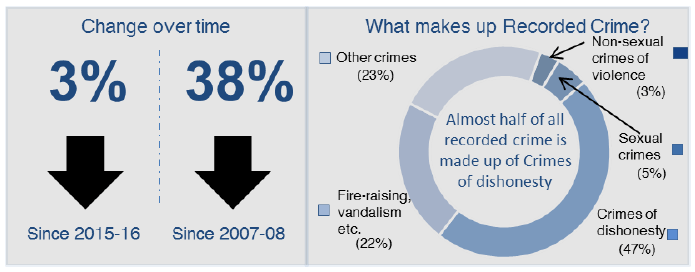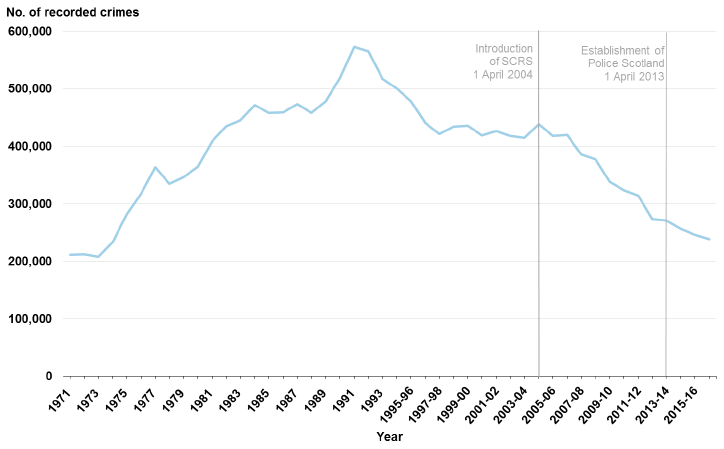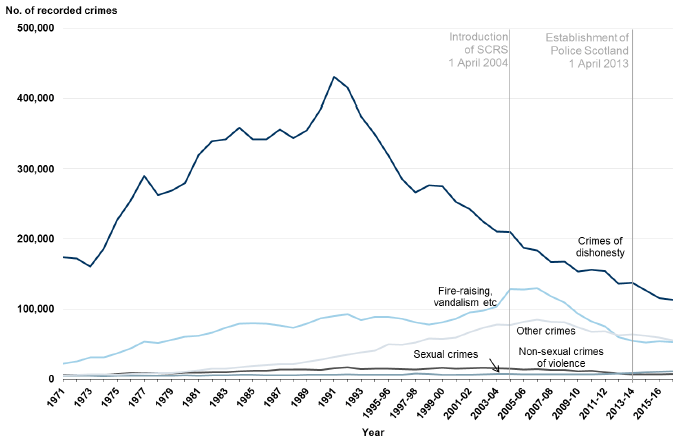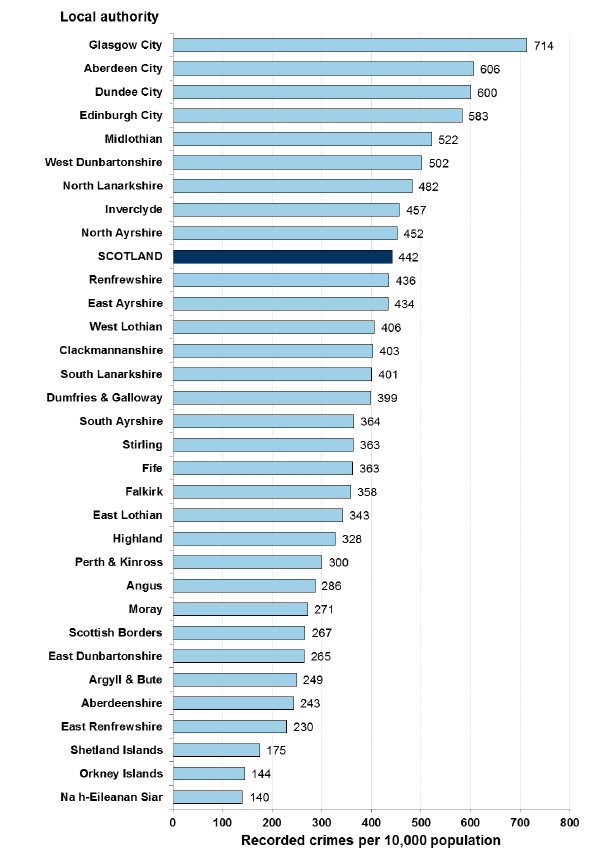Recorded crime in Scotland: 2016-2017
Statistics on crimes and offences recorded and cleared up by the police in Scotland, split by crime or offence group and by local authority.
This document is part of a collection
3. Main Findings: Recorded Crimes and Offences in Scotland
Total Recorded Crime

Recorded crime is at its lowest level since 1974. The total number of crimes recorded by the police in Scotland in 2016-17 was 238,651. This is 3% lower than the level recorded in 2015-16 ( Chart 1 and Table 6). Crime has been on a downward trend in Scotland since 2006-07, having decreased by 43%. This continues a generally decreasing trend in recorded crime in Scotland, from a peak in 1991 when crime reached a record high of 572,921.
Chart 1: Total crimes recorded by the police, 1971 to 1994 then 1995-96 to 2016-17 ( Table 10)

Chart 2 shows the number of recorded crimes in each of the five crime groups since 1971 and gives an indication of the scale of each crime group. At 47%, Crimes of dishonesty account for almost half of all recorded crime in 2016-17. This was followed by Other crimes (23%), Fire-raising, vandalism etc. (22%), Sexual crimes (5%) and Non-sexual crimes of violence (3%). These individual groups will be discussed in more detail in the sections which follow.
Chart 2: Crimes recorded by the police by crime group, 1971 to 1994 then 1995-96 to 2016-17 ( Table 10)

Local Authority analysis:
The overall decrease in recorded crime between 2015-16 and 2016-17 was reflected in 20 of the 32 local authorities, with 11 experiencing an increase and one with very little change from the previous year. Year on year figures can vary across local authorities, however the long term trend is broadly the same across Scotland. Chart 4 shows that since 2007-08, all local authorities show a decrease in recorded crime, varying from 13% in Midlothian to 61% in Na h-Eileanan Siar.
The largest fall in recorded crime between 2015-16 and 2016-17 was in the Shetland Islands (34%) where more than half (52%) of the decrease was accounted for by falls in the Other crimes group. This is in contrast to the previous year when the Shetland Islands had the largest increase in recorded crime.
The largest numerical decrease was in the City of Edinburgh, falling by over 2,300 crimes from 31,880 in 2015-16 to 29,558 in 2016-17. The largest number of crimes recorded were in Glasgow City, which includes 11% of Scotland's population [1] , but accounted for 18% (43,903 crimes) of all recorded crime in Scotland. It should however be noted that Glasgow's daily population will be higher than its resident population as people travel into the city from surrounding local authority areas for work, leisure and other purposes. Crimes are recorded in terms of where they occur and not the home residency of the victim (where the two places are different locations). The comparison described above for overall crime levels should be viewed in this context – which will also likely apply to Scotland's other city based local authorities.
The largest rise in recorded crime between 2015-16 and 2016-17 was in Midlothian (12%) where 78% of the increase was accounted for by a rise in Crimes of dishonesty and Other crimes.
One local authority, Fife, saw very little change in recorded crime between 2015-16 and 2016-17 ( Chart 3).
Further explanation of these trends is set out in the following sections for each crime group. Please note that further local authority level data for Tables 5-8 can be accessed online via the following link: http://www.gov.scot/Topics/Statistics/Browse/Crime-Justice/Datasets/RecCrime
Chart 3: Change in total recorded crime between 2015-16 and 2016-17, by local authority area

Chart 4: Change in total recorded crime between 2007-08 and 2016-17, by local authority area

Crime rate per 10,000 population
There were 442 recorded crimes per 10,000 population in 2016-17, with urban areas recording the highest rates; Glasgow City (714 per 10,000 population), Aberdeen City (606 per 10,000 population), Dundee City (600 per 10,000 population) and the City of Edinburgh (583 per 10,000 population) ( Table 13).
Chart 5: Total number of recorded crimes per 10,000 population 1, 2016-17

1. Population estimates are as at mid-year 2016 from the National Records of Scotland ( http://www.nrscotland.gov.uk/statistics-and-data/statistics/statistics-by-theme/population/population-estimates/mid-year-population-estimates)
Data Considerations
National Statistics on total recorded crime are based on data which Police Scotland extract from their IT system (called the Scottish Operational and Management Information System ( ScOMIS)) and submit to the Scottish Government. Prior to 2013-14 and the establishment of Police Scotland, the Scottish Government collected recorded crime data from the eight legacy forces, who in turn extracted the data from their own systems.
Despite the change in method of collection, the data presented in this section on total recorded crime (which comprises of Crime Groups 1 to 5) remains comparable both before and after 1st April 2013. The Scottish Government produced a Technical Report in 2014 which detailed the quality assurance work it carried out in reaching this conclusion: http://www.gov.scot/Topics/Statistics/Browse/Crime-Justice/PubRecordedCrime/TechnicalReport.
On 1 April 2004, the Scottish Crime Recording Standard ( SCRS) was introduced to help maintain a victim orientated approach to crime recording. It was anticipated that this might increase the number of minor crimes recorded such as vandalism and minor thefts. It can be seen from Chart 1 that this did cause a slight increase in 2004-05 as expected, but that the downwards trend returned following this change to recording practice.
Data Validation
HMICS Crime Audit 2016: Background
This bulletin reports on the number of crimes and offences recorded by the police in Scotland. On the 21 st September 2016, Her Majesty's Inspectorate of Constabulary in Scotland ( HMICS) published Crime Audit 2016. This audit assessed the extent to which police recording practices complied with the Scottish Crime Recording Standard and Counting Rules:
http://www.hmics.org/publications/hmics-crime-audit-2016.
HMICS audited 6,273 incidents reported to Police Scotland between the 1st January and 31st March 2016. HMICS took several factors into account when deciding what to audit – including areas identified as weak in previous audits, areas of high risk or emerging concern, national and local policing priorities, and areas which have not previously been subject to independent audit. Five categories were included, three of which related to specific crime types:
- Sexual crime
- Violent crime
- Vandalism (Damage)
- Non-crime related incidents
- No-crimes
HMICS Crime Audit 2016: National Results
The Audit found no systemic data quality issues around the recording of crimes and offences. The report found that 'the quality of most incident and crime recording decisions by Police Scotland is good'. 92.7% of incidents were closed correctly [2] and 95.1% of crime was counted and classified correctly'.
The report also found that No-criming practice was generally good, with 96.0% of the 876 cases which were initially thought to be a crime but were later re-designated as not being a crime following additional investigation, found to have been no-crimed correctly.
The Audit reported a significant reduction in the proportion of crimes recorded within 72 hours of being reported to the police, from 96.6% in 2014 to 90.8% in 2016. Whist the quality of recording decisions was found to be good overall, it did note evidence that delays in recording have contributed to a reduced level of compliance against the Scottish Crime Recording Standard (investigations can become more complex and detections harder to achieve if significant time has elapsed between reporting a crime and it being recorded by the police).
Non-crime related incidents
Non-crime related incidents are those incidents reported to the police which never result in a crime report. Of the 1,138 such incidents examined, 91.0% were closed correctly. This was a statistically significant improvement on HMICS' results for the same category in 2014 (87.2%). The improvement has resulted from increased scrutiny of incidents.
Divisional Results
The Audit report states that there 'are still some significant divisional variations in compliance rates'. Divisional compliance rates for Test 1 (whether an incident was closed correctly) ranged from 87.1% to 98.6% and for Test 2 (whether a crime was counted and classified correctly) from 90.7% to 98.8%.
The Test 1 compliance rate was significantly worse than Scotland as a whole for two of the 14 divisions; Ayrshire and Renfrewshire and Inverclyde. Four divisions performed significantly better (Dumfries and Galloway, Highland and Islands, Fife and Edinburgh). The result in Ayrshire for Test 2 compliance was on the borderline of being significantly worse than Scotland as a whole. Furthermore, the no-crime compliance rate in Lanarkshire was significantly worse than Scotland as a whole.
Readers should be aware of these factors when considering information relating to these three divisions. The following table shows the local authorities within these divisions:
| Division |
Local authorities |
| Ayrshire |
East Ayrshire, North Ayrshire and South Ayrshire |
| Lanarkshire |
North Lanarkshire and South Lanarkshire |
| Renfrewshire and Inverclyde |
Renfrewshire and Inverclyde |
Conclusion for the National Statistics
Overall this audit demonstrates that users of crime statistics can have confidence that crimes are being classified and counted correctly. As outlined above, users should be aware that crime statistics for some local authorities will be based on police divisions with lower compliance than the national average. Furthermore, as the audit is based on a sample survey of incident and crime records (rather than all records), the true value may differ slightly from the results in the audit. This is because sampling in this way is subject to a range of quantifiable and non-quantifiable error.
Further details from this audit in relation to compliance rates for specific crime types are provided within the relevant sections of this bulletin and Annex 2 on Quality of the Statistics.
Data Comparisons
In addition to the information on police recorded crime, crime in Scotland is also measured by the Scottish Crime and Justice Survey ( SCJS), a national survey with adults (aged 16 and over) living in private households which asks respondents about their experiences of crime. A comparison of the two sources is provided below [3] .
Comparison with Recorded Crime (comparable crime subset):
Of the 688,000 crimes estimated by the 2014-15 SCJS, around 60 per cent (414,000) can be compared with police recorded crimes. Further detail on the comparable crime set is available in Section 5.3.
Both recorded crime figures and SCJS estimates show downward trends in the extent of comparable crime between 2008-09 and 2014-15 (-38% and -43% respectively). The reduction in estimates across all sweeps of the SCJS, from 731,000 in 2008-09 to 414,000 in 2014-15, is a statistically significant change, as too is the short-term change in SCJS comparable crime between 2012-13 and 2014-15.
Contact
Email: Jamie Macfarlane, jamie.macfarlane@gov.scot
Phone: 0300 244 4000 – Central Enquiry Unit
The Scottish Government
St Andrew's House
Regent Road
Edinburgh
EH1 3DG
There is a problem
Thanks for your feedback